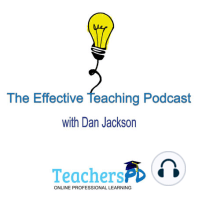10 min listen

Episode 36 Using problems and questions to enhance student learning
Episode 36 Using problems and questions to enhance student learning
ratings:
Length:
17 minutes
Released:
Apr 19, 2020
Format:
Podcast episode
Description
In this episode Dan discusses how the use of problems replicates real world learning and how questions drive inquiry.Using problems and questions to enhance student learning is licensed under a Creative Commons Attribution-NonCommercial-ShareAlike 4.0 International License.Join the Facebook CommunityVideo showhttps://youtu.be/DcSzmJJJtPcShow resourcesRegister for the Free WebinarsRegister for the free course Introduction to G-Suite for EducationShow notesProblems are real world. It is how we approach our own learning.How often do you begin your learning because you have run into a problem. The current biggest problem for educators is the sudden switch the remote learning due to covid -19If you're still struggling with this you can listen to episodes 32 to 34 for my special 3 part interview with Kelly Pfeiffer and if you are using G-Suite for remote learning I have a webinar this Monday the 20th that you can register for here. There will be a link in the show notes at teacherspd.net/36 I have also made my 12.5 hour NESA accredited course “Introduction to G-Suite for Education” free for anyone who is new to using G-Suite. Just go to TeachersPD.netBut, coming back… presenting learning as a problem replicates what learning is like for us, provides some authenticity to the learning and develops lifelong learning skills.Problems develop entrepreneurial skillsI personally own 2 businesses and can testify that owning a business and running a business is all about finding solutions to problems. These problems might be those of my clients that I hope to solve, or to create a product to solve. But they are also problems such as: no-one is coming to my site, they leave after only looking at one page. Or maybe people are having issues logging in, or how do I get my brand in front of my ideal clients…. These are all real problems I have had.Solving problems is how the next big company will be made. Facebook connects people around the world, Google organises the world’s information to make it accessible, and both were born out of a problem that the founders saw and then sought to solve even when others told them it was impossible.So, when you are creating learning in your classroom or at the moment, online. Try and present the learning as a problem to be solved. If you can use a real world problem that students could work on for your subject. egObesity is increasingPandemicsPeople are losing jobsOr maybe you have a local problem they can solve, like how to increase the diversity of flora and fauna at your schoolAdditionally, when you present problems consider things such as:Student choice, which will increase the authenticity and connection to their life and then increase learning and engagementConsider if Students can manage the challenge (don’t restrict them completely, but don’t be unrealistic either)And finally, make sure that the problem you pose relates to your course contentWhen it comes to using questions you are really looking to drive inquiry. Next week I’m going to be talking about all inquiry, so today I really just want to say that questions for inquiry must be non-googlable! That is, the answer should not be straight forward.It should force the students to consider multiple perspectives and multiple sources of information in order to answer it in the manner in which they do.These types of questions tend to relate very closing to presenting problems. For example, you might pose a problem through a question such as:How do we improve our health during isolation?Why do we each respond differently to the same text?How do we know what happened in the past?You will notice with these examples that they all start with how or why and are personable. In order to craft a good question for students learningThey should start with How or why rather than what, when or who. This helps to make them more open ended, open to interpretation and allow greater depth of..
Released:
Apr 19, 2020
Format:
Podcast episode
Titles in the series (100)
Episode 25 Reaching Every Student with Jon Bergmann by Effective Teaching